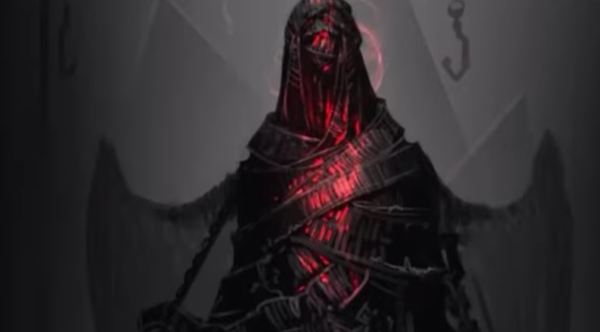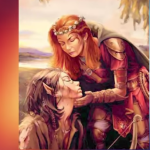By Jacobe Simon-Hanks
The Dungeons & Dragons Wizard class is a classic yet powerful class that any player can use with the right build. With features ranging from the required Spellcasting and Arcane Recovery features to the powerful level 20 Signature Spells this class utilizes a high intelligence modifier to truly excel at any table or digital space.
Player levels range from 1 to 20, but spell levels can range from level 1 to a maximum of level 9. At Wizard level 3, the player earns the ability to add 2 level 2 spells to their spellbooks on top of the level 1 spells they have access to. With a plethora of options, players looking to optimize their builds may find choosing the right spell for their party difficult.
To make the process easier, this article will compile the best level 2 Wizard spells D&D 5th edition has to offer. Grab your spellbook, favorite pen, and an ungodly amount of dice, and let’s get started!
1. Hold Person
Hold Person allows the user to choose a humanoid they can see within a range of 60 feet. The target must succeed a Wisdom saving throw or be paralyzed for 1 minute, or until they succeed a Wisdom saving throw at the end of their turn.
At higher levels, this spell allows the caster to choose multiple targets.
Hold Person is great for offense but can also function as a good utility spell, especially if cast out of combat or preemptively.
Assuming the target is not particularly wise, players can assume they will succeed in stunning their target, effectively removing them from combat until a lucky roll or concentration is otherwise broken. Paralyzing a boss just before their turn or paralyzing the strongest threat among a hoard of enemies are just a few of the ways Hold Person can turn a difficult fight into a breeze for your party.
2. Rime’s Binding Ice
Similar to Hold Person, but with damage and a cool ice motif. This is a must-pick for thematic builds. This spell covers a 30-foot cone with ice, and creatures caught inside must make a Constitution saving throw or take 3d8 damage and be hindered by ice bringing their speed to 0.
On a successful save, targets take half the damage and are not hindered. This gives the spell an average of 13 damage per cast, which is a lot of damage when players are only level 3.
While the spell might fall off without casting at higher levels later into campaigns, it is still a strong and versatile pick and functions as a strong contender for the best level 2 spell.

3. Wither and Bloom
Necromancers and those who dabble in the art of life and death will want this spell in their spellbooks. It allows the caster to choose a point within range, 60 feet, and create a 10-foot radius sphere around the selected point.
What makes this spell unique is that the caster chooses which creatures are affected- those the caster means to harm must make a Constitution saving throw or take 2d6 necrotic damage, halved upon a successful save.
Creatures the caster means to help can spend one of their available Hit Die, roll it, and recover that many points of health plus the caster’s spellcasting ability modifier. For effect and flavor, any non-magical vegetation within the sphere withers.
4. Alter Self
A truly versatile spell with three different variants built in. While Natural Weapons may not be the most optimal, it can still find a place in builds where weaponry or multi-classing needs a wizard.
Aquatic Adaptation is great for traversing underwater, and should be high on the priority spells list if the campaign setting is watery- port towns, ocean sailors, underwater kingdoms, etc. Having access to Aquatic Adaptation allows for a wide variety of travel options, and Alter Self can combine with other spells such as Air Bubble or potions that support the rest of the party.
Last but certainly not least, Change Appearance is arguably the most useful of the three options this transmutation spell offers. It could be a spell on its own as it allows the caster to completely change how they look to whatever they choose, down to the hair length, skin tone, race, and even their voice.
A user cannot change their size, but height can still range heavily between creature sizes. Change Appearance is great for stealth or espionage, having to take the form of a stranger or become a known figure, and should be considered for every wizard’s toolkit.
Short rule recap
- Alter self is a 2nd-level transmutation spell that allows you to change your appearance in various ways.
- You can change your height and weight by up to 1 foot, your facial features, your skin and hair color, and your voice.
- You can also give yourself gills, webbed hands and feet, or natural weapons (like claws or fangs) for a limited time.
- The spell lasts for up to 1 hour, and you can end it early as a bonus action.
5. Detect Thoughts
Another versatile spell for its utility, Detect Thoughts is an amazing choice for roleplay-heavy tables. With a bit of creativity, the caster can direct the thoughts of their target with a question, then utilize the spell to discern important and relevant information.
The spell also allows for scanning the area for intelligent life forms by replacing the specific target’s thoughts with a wide ranged detection technique instead. If the caster suspects they are being watched, they can spend the spell slot for an immediate answer and react accordingly.
Rule recap:
- Detect thoughts allows you to read the surface thoughts of a creature within range for up to 1 minute.
- The target must make a Wisdom saving throw to resist the spell’s effects.
- You can probe deeper into the target’s mind with an additional action and Wisdom saving throw, but the target can block you if it succeeds.
- The spell has a 30-foot range and can’t read the thoughts of creatures without a language or Intelligence score of 3 or lower.
- Using detect thoughts to invade someone’s privacy is considered unethical and could have consequences.

6. Warding Wind
An almost absolute requirement for wizards wanting to bolster their defenses, Warding Wind offers many powerful ways to defend against foes. The spell deafens the user, which means they can no longer hear verbal-based spells or be affected by any other auditory effects.
It also creates rough terrain, making approaching the caster more difficult. To add to this, any attacks that go against or through the wind are made at disadvantage, so not only is it hard to approach, but it is also hard to hit the wizard. Unprotected flames can be snuffed out when the spell is cast, hindering creatures that do not have Darkvision.
Lastly, the spell will clear smog or cloud effects around the caster, making the air safe and breathable. This spell works well as a countermeasure to many threats and is best used preemptively before combat begins. If the caster is able to maintain concentration, then the spell will last a total of 10 minutes, which is usually enough in-game time to settle combat. Also good for thematic builds and wanna-be Air Benders.
Rule recap
- Warding wind creates wind around you for 10 minutes.
- Ranged attacks have disadvantage, you have advantage on inhalation-based saving throws, and unprotected flames are extinguished.
- Moving into the wind reduces speed by half.
- Doesn’t protect against melee attacks or spells and may affect allies.
7. Misty Step
Misty Step is a low-level teleportation spell and can be used as a bonus action. This is great for action economy as the caster can dip out of adverse situations while still maintaining their action. If there is room in your spellbook and you are lacking movement or versatility, this spell should fill that gap perfectly!
Rule recap
- Misty step is a 2nd-level spell that allows you to teleport up to 30 feet to an unoccupied space.
- You can cast it as a bonus action, bypass obstacles, and take an action after teleporting.
- It doesn’t make you invisible or grant protection, and you can’t teleport to an occupied or unseen space.
- It’s popular for its versatility in combat and exploration situations.
8. Invisibility
Not limited to self-targeting, Invisibility does what the name implies: turns a target invisible. While there is no guarantee the invisible subject will always be undetected, casting this on the party Rogue will net hefty bonuses when coupled with the Hide action.
Once a party member becomes well-versed in the art of stealth, this spell will become a cornerstone for all combat encounters as well as many role-playing opportunities. Your table’s Dungeon Master will either love or hate balancing around this spell’s incredibly versatile potential.
Rule recap
- Invisibility makes you or a touched creature/object invisible for 1 hour.
- Attacking or casting a spell ends the spell, but while invisible, you have advantage on attacks and disadvantage against attacks that rely on sight.
- Invisibility doesn’t protect against area-of-effect attacks or leave behind physical traces.
- It’s a common tactic, but use it with caution and consideration.
9. See Invisibility
Partly defensive, partly utility, fully the opposite of the last spell, See Invisibility is an investment type of spell.
In the early stages of a campaign, this spell may not have too many uses, but later in the game and when cast at higher levels, the increasing amount of enemies that can become invisible or ethereal will not seem as threatening.
The spell does not require concentration either, so taking a bit of damage will not reset the caster’s momentum, and their next turn could pay off in a big way.
Rule recap
- See invisibility is a 2nd-level spell that lets you see invisible creatures and objects for 1 hour, and into the Ethereal Plane.
- It doesn’t reveal hidden or magically concealed targets, nor grant additional senses.
- It’s useful for detecting hidden threats or bypassing illusions, but use it with caution and respect.
10. Web
You might be thinking “Isn’t this just like Hold Person and Rime’s Binding Ice?” And you might be right. But you are also wrong. Web does limit action economy much like the aforementioned spells, but unlike Hold Person’s concentration requirement or Rime’s focus on damage, the cast webs remain in play, unless destroyed, and both restrains those caught inside as well as negates certain areas of travel.
Placing Web as a layer over a flat surface gives 5 feet of thickness, making it very effective at stopping enemies in their tracks. It can also be used as a trap or defensive measure if combat requires holding a specific space under your party’s control.
Web utilizes two types of saving throws, Dexterity and Strength, so unless the target is high level, there is a higher chance this spell will do its job as opposed to Rime’s and Hold Person’s single saving throw check. Most importantly, you get to pretend to be Spider-Man for a turn, and who wouldn’t want that?
Rule recap
- Web creates sticky webbing on a surface that lasts up to 1 hour.
- Creatures that enter or start their turn in the webbing may become restrained with a Dexterity save.
- The webbing can be destroyed by fire or certain spells.
- It’s versatile and can be used to restrict movement, create barriers, or set traps, and is effective against mobile or low Dexterity creatures.
Final words on best 5e level 2 spells for wizards
That’s it for the best level 2 Wizard spells. While not every spell will fit into every wizard’s toolkit- these aren’t Firebolt after all- anyone can find a reliable and powerful use for these picks.
The best part is their low-level spell slot allows for multiclass options to take advantage of these spells almost as much as pure level 20 Wizards do. Many of the spells overlap with other class’s spell options too. So if there is a particularly devious combo lurking and your group has two spellcasters, well, let’s just say the Dungeon Master better not be too attached to their difficult encounters. Happy dice rolling!
